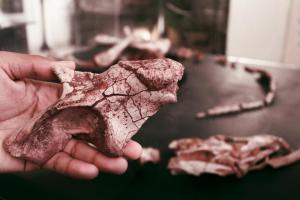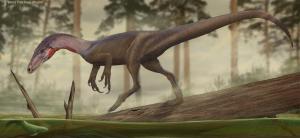A study published in the scientific journal The Anatomical Record on November 16 presented the second record of a dinosaur for the municipality of Restinga Sêca. The research was conducted by Maurício S. Garcia, Flávio A. Pretto, Sérgio F. Cabreira, Lúcio R. da Silva, and Rodrigo T. Müller, from the Center for Paleontological Research Support of Quarta Colônia (Cappa) at UFSM.

The finding is particularly significant because dinosaur fossils are still rare in the municipality of Restinga Sêca, Rio Grande do Sul. The specimen in question consists of a left ilium – a bone that is part of the hip – discovered by Dionatan Cabreira while helping his father, Sérgio, search for fossils. The bone features indicate that the fossil belonged to a dinosaur from a group called Herrerasauridae. In the world, dinosaurs from this group are known in Brazil, Argentina, and the United States. Surprisingly, the study revealed more similarities with the forms found in North America.

The herrerasaurus comprises an intriguing group of dinosaurs that existed around 230 million years ago, in the Triassic Period. These animals represent the first medium to large-sized predatory dinosaurs, capable of reaching up to 6 meters in length. Although the fragmentary condition of the new fossil hinders its recognition at the species level, the discovery suggests the presence of a hidden diversity of dinosaurs in the Triassic of Rio Grande do Sul, as it is different from all other Brazilian herrerasaurus.
This fact highlights the importance of analyzing fragmentary specimens to more accurately quantify the diversity of extinct forms. Finally, the discovery emphasizes Brazil as a crucial location for paleontological research, providing valuable information about the early stages of dinosaur evolution and adding an important chapter to the rich history of South American dinosaurs.
The research received support from the National Council for Scientific and Technological Development (CNPq) and the Coordination of Improvement of Higher Education Personnel (Capes) and was developed as part of the master’s thesis of Maurício Silva Garcia, by the Animal Biodiversity Graduate Program at UFSM, under the advising of paleontologist Rodrigo Temp Müller, from Cappa/UFSM.
The fossil is housed in the scientific collection of the Center for Paleontological Research Support of Quarta Colônia/UFSM in São João do Polêsine.
Original text: https://www.ufsm.br/2023/11/24/novo-fossil-de-dinossauro-e-encontrado-pelo-cappa-ufsm-em-restinga-seca









